Increase Performance on the Strongman Log
by Jedd Johnson, CSCS author of Ultimate Forearm Training
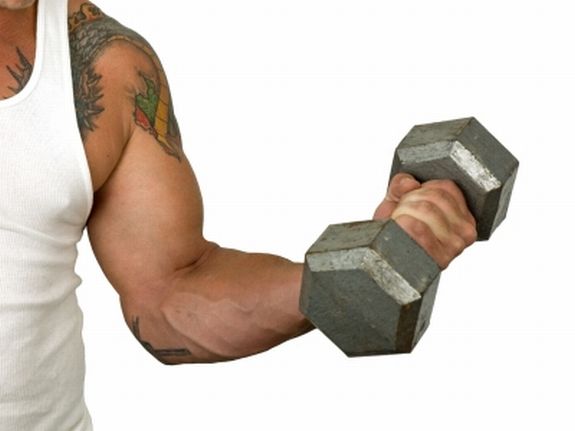
Its easy right, you just lift the log up, clean it to your shoulders like a bar and press it right? Well, it isn't that easy.
Many, including myself, have been very surprised at the difficulty of the log press, even after lots of experience under the bar in the bench press and in the Olympic lifts. When I first started cleaning and pressing the log, I didn't have a lot of knowledge of the proper technique. This article will show several techniques we at Diesel Crew and others have used. And while I am not a champion presser, I do consider myself to be a decent presser. I think one of my keys to improvement in the log press over the years has been my ability to gravitate toward the proper form and strengthening my weaknesses. This is an underlying principle in the Diesel approach to systematic training for strength.
Again this article is written with experience in mind. My objective for writing this article is to cover the various techniques that I have tried over the years. You'll see some techniques that I've used that were not optimal - these are the steps in the learning process that I hope you will learn from and ultimately skip, so that you arrive at the best technique for you. I will also discuss techniques for improving performance on the log clean that will make you a better strongman athlete, and a better all around athlete.
Cleaning the log
The log clean is the act of getting a log from the ground to the shoulder. How the athlete performs this part of the log press event can usually predict whether or not the athlete will be successful in pressing the log overhead. If their technique is lacking, or if they use up too much energy just to get the log to the shoulder, there is very little chance, unless they are extremely strong in the legs and triceps that they will stand erect with the log overhead. In fact, for many who are new to the sport of strongman, the first time they grab hold of the strongman log, especially if it is in around 12 inches in diameter, they get quite a shock.
The first thing they notice when they try to lift the thick log is that the center of gravity of the log is very far out from the body. Unlike the normal Olympic bar that sits right up against the shins and can be cleaned to the shoulder in a path that is similar to a straight line, the handles on the log sit away from the shins. If you don't have a log to try, you can get a sense of how far it sits by trying to clean an Olympic bar to your shoulders by first pulling it over a pail. The pictures below show the mechanical advantage of the Olympic bar versus the mechanical disadvantage of the log, using the comparison of pulling the bar over top a pail.
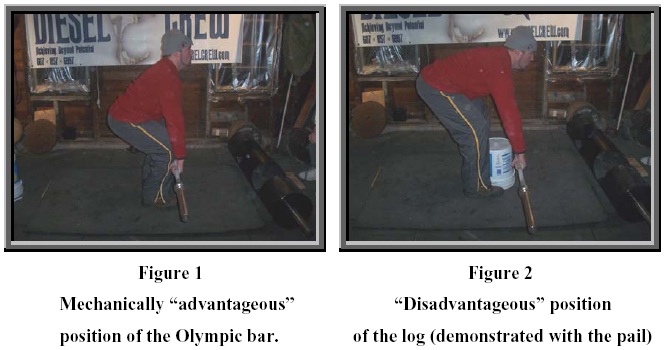
This mechanical disadvantage is the just the beginning of the additional challenges that are part of the log clean.
Another way that cleaning a log differs from cleaning the Olympic bar is that even after breaking it from the ground, you can not simply explode it up to the shoulder in a straight line path. Instead, the log must be actively turned between the position where the log nears the waist and where it is racked at the shoulders. This turning must take place in order to position the handles facing down with the hands underneath. There are several ways I will discuss to turn the log when moving it from waist position to the shoulder position, and in doing so, completing the log clean. I will also discuss each technique's energy efficiency, and whether the technique is generally allowed in competition.
Belt Assisted Technique
The first technique can be referred to as the Belt Assisted Technique, where the athlete pulls the log up onto the belt or towel looped on the belt, and then hip thrusts it to the shoulders. This is the first technique I learned when embarking on my journey of log lifting. I had seen photos of a very old strongman contest where the athletes looped a huge towel onto the belt and used this looped belt as a platform to support the log. See below.
Figure 3 - The athlete deadlifts and pulls the log on top of a towel looped through the belt.
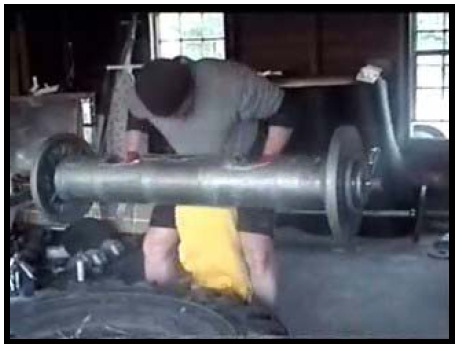
Figure 4 - The athlete extends the hips forward explosively, propeling the the log to the shoulders. This is where the active rotation of the log takes place.
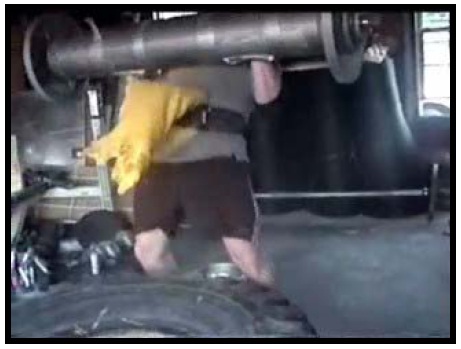
Figure 5 - After actively turning the log, the athlete catches it in the rack position in the front delt / clavicle area.
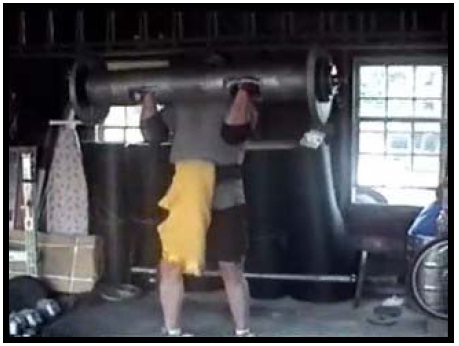
Now, check out this video. This is of me using the belt assisted technique back in 2004. You'll see that since the log rests on the towel, it is very easy to explode up, almost directly to the shoulders, even at 300 pounds.
http://www.dieselcrew.com/videos/logstudy3.wmv
That was only an 8 inch diameter log. The small diameter makes it much easier to clean and press, but mostly, the ease of the lift is due to the surface area of the blanket draped over the belt.
This technique is probably the most energy efficient, but also is pretty much out of the question. Why? Most promoters do not allow the towel to be used. With a thick enough towel, this technique makes it MUCH easier to hold the weight at the waist level. Bicep strength is not an issue with this technique because the log is balanced on the towel, instead of the athlete's arms straining to hold it up. Essentially, the towel looped through the belt becomes a rack that will support the weight of the log for the athlete. Therefore the towel has been banned in most competitions.
Many promoters are going as far as requiring the belt to even be turned around so that the buckle is in the back. If the buckle is in the front, it too can be used as a racking device for supporting the log. While these supportive techniques allow the athlete to move around some pretty impressive weight, it short changes the athlete in a way because the Belt technique makes the lift so much easier. It would be a big mistake to train using this method for a contest, only to arrive and find out the technique is not allowed. In the end it is wiser to train with the other techniques that exist.
Power Curl
Another option is the Power Curl. This is an explosive movement, which requires immense power to move the log upward. There is less of a need to actively rotate the log in this case, because the handles of the log arc in the same plane as the hands. Instead of rotating the apparatus, the athlete arches during the latter portion of the curl to get his/her body underneath the log before momentum ceases.
To understand this concept, check out this series of pictures using the Power Curl technique.
Figure 6 - The athlete pulls the log from the ground to the waist or mid-hips.
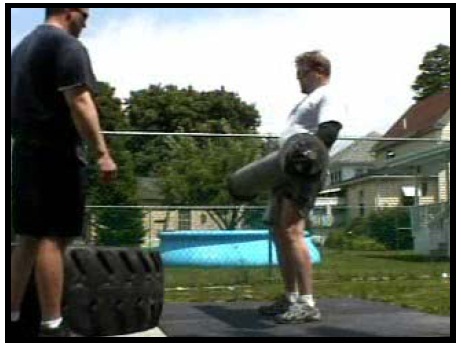
Figure 7 - The athlete drops slightly and initiates a loading phase in order to generate a strong stretch reflex in the hip extensors.
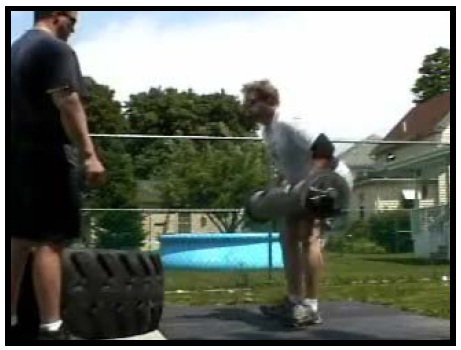
Figure 8abc - The stretch reflex initiation is followed by hip extension combined with an intense arching movement where the athlete attempts to get underneath the log while performing the curl. This arching of the back and hips is necessary in the upper ranges because most athletes will not be able to generate enough power from the hips to get the implement all the way to the shoulders. In most cases, the momentum will stop around the level of the rib cage. This is when the athlete must engage the biceps at full capacity and get under the bar in order to catch the log in the rack.
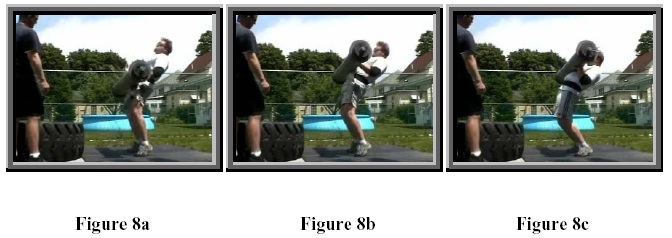
Figure 9 - The athlete catches the log high on the chest or at the shoulder level and positions the bar for the press.
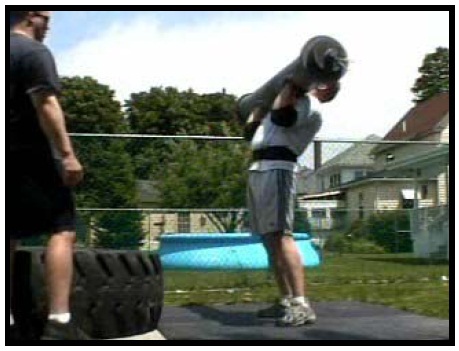
Unlike the Belt Assisted Technique, this technique will probably be allowed by any promoter that runs a contest in the world today because it is entirely dependent on the brute strength and speed of the athlete, and relies on no assisting devices, like the towel or the belt buckle. However, this style is not optimal either, because it is not energy efficient. Let's look closer and see why this movement is not energy efficient.
The first drawback to this technique is the amortization phase. After pulling the log to a standing position, the athlete actually pauses, then lowers the log in hip flexion in order to gain a stretch reflex. Then, the athlete changes directions once again in a violent succession of triple extension (hips, knees, ankles), arching of the back, and flexion of the biceps in the power curl fashion. During this phase, the hands must hold the log handles throughout the entire range of motion, zapping the athlete's grip. This additional time under tension will deplete the athlete's ATP and Glycolitic energy stores. This sequence also causes the athlete to lose momentum in the lift. The arching of the back zaps the athlete's erectors, glutes, and extensors. More energy is consumed when receiving the log in the rack position - often it crashes down because it has left contact with the athlete's body. It is then necessary for the athlete to propriocept and balance himself from the tremor-like effects of catching the log with this technique. Finally, this strategy eats up the competitor's time. By far, this is the slowest technique of the three discussed here, and consumes the most energy per repetition.
Energy conservation is very important in Strongman events that rely on endurance like the log press, so it does not make good sense to use this technique in competition. Besides, once you get the log to your shoulder, you're not done - you still have to get the log overhead for the repetition to count. After all, the event is called the Log Press, not the Log Get-it-to-Your-Shoulder. Since the Log Press is a two part movement, the technique in raising the Log to the shoulders must be concise, and when preserving your energy stores for that big One-Rep Max lift or for the Log Medley, it makes little sense to use a technique that can have you worn out only half way through.
With that said, let's look at the variation of log clean that I call the Squat Clean.
Squat Clean
This technique is legal in all promotions as far as I know, and is fairly good for conservation of energy. I really feel like I have a lot more left in the tank when I use this log clean style. Let's look at a few pictures to see how this technique is performed.
Figure 10 - The athlete rows the log to the hip/waist area.
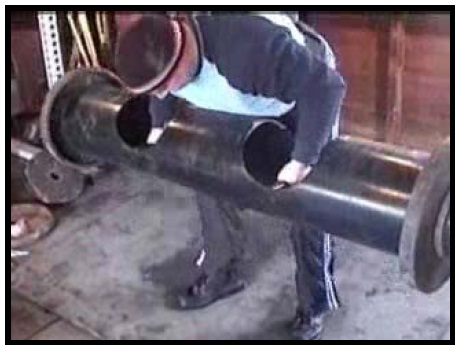
Figure 11 - Without pausing, the athlete drops down into a partial squat position, holding the log atop his thighs with the elbows in a flexed position. At this point, the athlete should regain his or her breath, “hugging” the log in contact with the belly/torso.
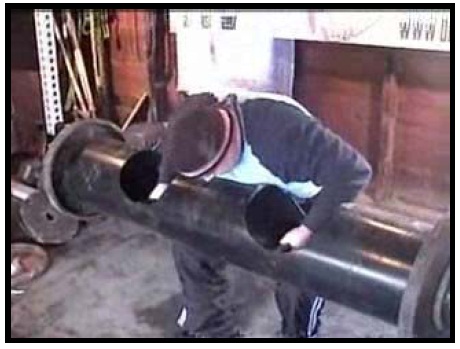
Figure 12 - In one succinct motion the athlete explodes upright in triple extension, simultaneously rolling the log up the chest to the shoulders, arriving in an upright position, ready to press. The log stays in contact with the torso throughout this movement.
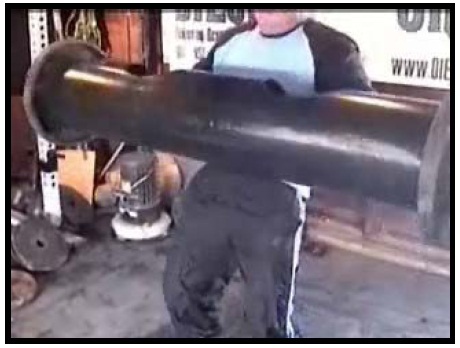
Figure 13 - After exploding up, the athlete actively rolls the log in a curling motion. The log stops at the top of the chest/front deltoid area.
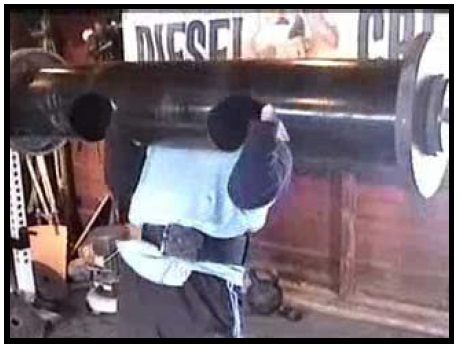
It is the motion executed in Figures 11 and 12 where the athlete is able to take advantage of the benefits of this technique that accomplish energy conservation. Instead of initiating an amortization phase, the athlete immediately crouches down to regain his breathe and prepare for the completion of the repetition. Also, using up the grip is avoided by supporting the weight of the log on the thighs. With this technique, the log never leaves the athlete's body. There is no need to recover from the log ballistically landing in the rack position, and there is less multi-planar proprioception involved. Instead, momentum is gained from the tremendous forces produced during the upward movement of triple extension, combined with the contraction of the biceps and the slight extension, or forward movement, of the humerus and extension of the back. When done right, the log rolls from the hips up the ribs and to the shoulders. From there it should be pressed for a finished repetition and victory.
In order to be successful at the Log Press, you must work to make your Log Clean as efficient as possible. In my opinion, the Squat Clean technique is the most efficient. In fact, the Squat Clean is widely used by many strongman athletes these days, especially those that are winning the contests.
Home Made Strength Online DVD

More Articles By Jedd Johnson
Return to the Workout Articles Archive
|